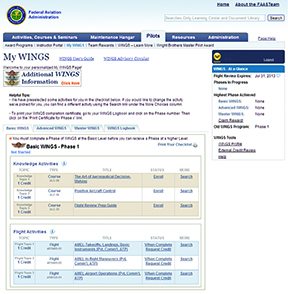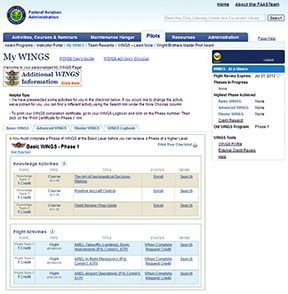The FAA’s WINGS program has been a key element of joint agency/industry safety education efforts for many years. It is considered gospel among many general aviation safety advocates, and the program has indeed produced positive results. Yet, many are concerned it reaches only a fraction of those pilots who need it, and the positive safety results the program achieves would have resulted anyway because of the safety culture embraced by its current “church-goer” participants.

288
More important, root-cause analysis of fatal accidents suggests the program’s content does not adequately address the underlying reasons behind most fatal accidents, although that is also beginning to change. The key questions to answer are whether the program is reaching the right people with the right knowledge and proficiency training. Let’s start with a review of how the program has evolved to its current status.
Origins and Evolution
The WINGS program, officially known as the FAA WINGS Pilot Proficiency Program, is perhaps the core element of the FAA’s general aviation safety education efforts. The safety program has been around a long time, with the first tests begun in 1969, followed by the formalized Accident Prevention Program in the early 1970s. The WINGS program was added in the 1980s, while the overall program was renamed the FAA Aviation Safety Program in the 1990s, thanks to industry sensitivity to the negative connotation of the previous name.
In the first decade of the new century, the safety program was changed significantly in response to tighter FAA resources and the need to more efficiently address accident causes. The result is a Web-based option for knowledge course development and delivery, and more rigid requirements for completing knowledge courses and flight proficiency activities. The old course delivery method of live seminars was de-emphasized and greater focus was placed on computer courses using online or DVD delivery. The flight proficiency requirements for successful completion of the program have also been progressively increased. Initially, the flight requirements only required the participant to obtain dual instruction for a certain number of hours. Now the participant must meet the standards specified in the appropriate practical test standard (PTS).
Some miss the live seminars, since they permitted more interchange among participants and were a kind of social event. Live seminars are still available but the old days of the previous programs where the FAA “man in the van” made his or her rounds in each FAA district to dispense safety education and “war stories” are now pretty much over.
The current program is now known as the FAA Safety Team (FAAST) and the number of FAA aviation safety inspectors assigned to the program has been reduced. Rather than their previous role as “circuit riders” the current FAA members—known as FAASTeam Specialists—oversee the development of FAA and industry knowledge courses that are increasingly Web-based. They also appoint and monitor industry participants known as FAASTeam Representatives who carry most of the field activity burden, including conducting the remaining live seminars.
Despite the nostalgic wishes of some, I believe the changes in the program were necessary, especially when considering how training material is developed and delivered. Technology advances have made it possible to obtain training material anywhere, anytime, at a pace suited to any participant. The FAA can thus potentially reach many more people with many less resources. This is how government should work.
While researching this article, I obtained some participation and other data on the WINGS program from FAA program officials. These data are summarized in the sidebar at right. I also completed all three of the courses examined in the sidebar, plus a course offered by King Schools, Practical Risk Management for Single Pilot IFR. It’s beyond the scope of this article to compare and contrast these offerings from the point of view of the typical GA pilot. All of them did cover risk management to varying degrees but none of them were completely ideal or offered a full treatment of the subject. They are a big step forward in the process of educating pilots about risk management and I’m hopeful the next generation of these courses or other offerings will hit the mark closer. In my view, a comprehensive initial course will cover risk management principles and techniques, illustrate them with accident examples, and include a comprehensive exam built around a case study. None of the current offerings have all of these elements.
Root Causes?
As I have cited in numerous articles in this journal, poor risk management is the likely root cause of between 70-75 percent of fatal general aviation accidents. The relatively static fatal accident rate over the last decade is likely due to the fact that our pilot training system has yet to completely make the transition to the 21st century—or the late 20th century, for that matter. This includes a standardized recurrent training system which, for most of general aviation, means the WINGS program or the flight review.
To the credit of FAA and some portions of the general aviation community, we are starting to make progress in addressing fatal accident root causes by recognizing the importance of teaching effective risk management and slowly getting the community to embrace such a culture. This is, for example, reflected in the knowledge requirements for the WINGS program, at least at the basic level. Beginning in late 2011—when the WINGS User’s Manual was first issued—aeronautical decision making and risk management were both specified as a component for the core knowledge subjects.
More Flexibility?
At the heart of the WINGS program has been its historical “one-size-fits-all” structure. As I previously noted, this has changed for the knowledge requirements. The current requirement for three units, with its aeronautical decision making core course in the Basic level, is headed in the right direction. With some modification to the ADM and risk management courses that are available, this has the long term prospects of improving safety performance for those who complete these requirements.
In my view, the main issue is with the flight proficiency requirements where the one-size-fits-all approach still holds at the Basic program level. At the Advanced and Master levels, the “category/class specific causal factors” requirements needs to move beyond the PTS maneuver-based requirements to an ADM/risk management scenario-based approach. Since about 75 percent of fatal accidents have poor risk management as a root cause and only about 10 percent are due to faulty maneuvering, we need to rethink our approach.
Another factor lurking in the background is that there is no real incentive for pilots to complete the WINGS program. It takes from three to six times as much time to complete WINGS as it does to complete a flight review and time is the coin of the realm for most of us these days.
I’ll be frank; I complete a flight review rather than a WINGS program. I may be a poor example, given the nature of my work and the fact that I have 9500 hours, 3500 in type and fly 150 hours per year, every year. So let’s take a more typical 500-1000-hour pilot with 50-100 hours in type who flies 50-100 hours per year. Does an active, proficient pilot need the three hours of PTS maneuvers for WINGS every year, or even every other year? Does he or she even need a flight review every two years?
I recognize that the average pilot flies very few hours and even that is probably decreasing. If you fly 10 hours per year, the flight review isn’t stringent enough and neither is the WINGS program. If you haven’t flown in 90 days or more, you probably need a “mini” maneuver-based review before you go—and that’s exactly what most schools and FBO’s require of their renter pilots.
Outside-The-Box Proposal
What I have been leading up to is a bold proposal to rethink the current WINGS program and flight review—and it won’t take a rule change.
I believe that for pilots who fly a lot and have high total time and time in type, and who remain accident and incident free, that the flight review or conventional WINGS flight proficiency requirements can be extended to three or even four years. I would attach strings. You would need to log so many “events” each year and not just bore holes in the air. For example, if you’re instrument-rated and want to use those privileges, you’ll need to fly so many flights in the system under a real IFR flight plan. Forget the PTS requirements that emphasize holding pattern entries and other maneuver requirements. Instead, I want to see a track record of successful performance in the real world.
There is one other mandatory requirement. You would need to complete an annual risk management course that emphasizes risk management techniques and procedures, accident case studies, a case study appropriate to your privileges and an exit exam. All of the current WINGS ADM offerings would need to be revised to meet this requirement.
None of this takes a rule change. It would be an administrative amendment to the current AC, since it’s just another type of “FAA-sponsored pilot proficiency program.” I would call it “PRO WINGS—the proficiency program for active pilots.”
But I wouldn’t ignore low-time pilots either. This option could be available to you also although the two-year minimum requirement for some form of dual instruction would apply unless you met certain activity criteria.
What You Can Do Now
Whether this idea gains traction or not, there are things you can do now to increase your risk management proficiency under the current requirements:
• Take one of the ADM or risk management courses offered under the current WINGS program.
• Apply what you learn to all your flight activities.
• When completing the WINGS flight proficiency requirements or flight review, ask your instructor to create a real-world scenario such that your risk management techniques are honed while still accomplishing the required PTS “drills.”
If you agree with my suggestions (or not), provide comments through the FAASTeam. It’s the only way the program will continue to improve.
Robert Wright is a former FAA executive and President of Wright Aviation Solutions LLC. He also is a 9500-hour ATP and flight instructor. His opinions in this article do not necessarily represent those of clients or other organizations that he represents.




